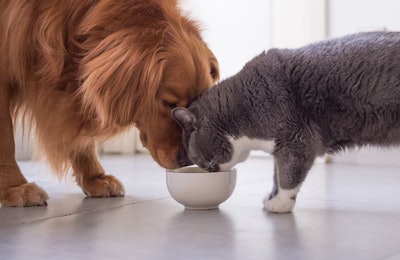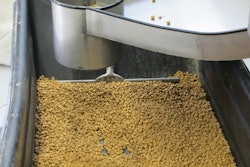
Probiotics and prebiotics have become almost staple ingredients in pet foods as their health benefits have become better known, and as researchers learn more about the importance of the gut microbiome. At the same time, understanding the benefits of these products to their own health, pet owners now often seek probiotics and prebiotics in their pets’ foods.
But what about a new digestive health trend: postbiotics? These are emerging as potential functional ingredients in foods and beverages for humans – does that mean they will follow in pet foods, too, as do so many other human health trends?
The case for functional digestive health ingredients in pet food
Citing data from Mintel as well as their own surveys, Kerry, an ingredients supplier to both human and pet food, recently reported that from July 2018 to June 2019, probiotic/prebiotic claims on dog and cat foods in the U.S. had a 15% incidence rate; and from 2015 to 2019, the number of new production introductions with probiotic functional claims rose 92%. In 2019, just from January to April, 136 new pet food and treat products launched with probiotic claims, according to Mintel, up from 69 for the same period in 2017.
The increases are likely at least partially due to consumer demands: 62% of U.S. consumers said they’re aware of probiotics, and 20% said they were interested in purchasing pet food products with digestive health benefits.
Postbiotics: new frontier in microbiome science
Into that welcoming milieu, enter postbiotics. Though a quick Google search shows articles and studies going back a few years, it’s telling that even peer-reviewed articles published in the last two years still set out to establish and define postbiotics – that’s how new the concept is.
Here are a few of the definitions I encountered:
- “Postbiotics refers to soluble factors (products or metabolic byproducts), secreted by live bacteria or released after bacterial lysis, such as enzymes, peptides, teichoic acids, peptidoglycan-derived uropeptides, polysaccharides, cell surface proteins and organic acids” (Aguilar-Toala et al., 2018).
- “Postbiotics are functional bioactive compounds, generated in a matrix during fermentation, which may be used to promote health. The term postbiotics can be regarded as an umbrella term for all synonyms and related terms of these microbial fermentation components” (Wegh et al., 2019).
- “Postbiotic metabolites are the new frontier in microbiome science. Scientists are learning that postbiotic metabolites are the master health-regulating compounds in the body. Your probiotic bacteria produce postbiotic metabolites, which are the tools that make up your ‘tool kit’ for good health. People who have a wider range of tools in their microbiome tool kit have a more effective tool kit, which does a better job regulating health throughout the body” (Pelton, 2019, sponsored post).
- “Prebiotics + probiotics = postbiotics,” said Will Bulsiewicz, MD, a gastroenterologist and author of a book out this year, Fiber Fueled. He was quoted by Emily Laurence in an article on WellandGood.com. “What this means is that when you feed [with prebiotics] the good bacteria [probiotics] that live in your colon, that bacteria will turn around and reward you with a gift. And that gift is postbiotics,” he explained.
While Bulsiewicz went on to say that, unlike prebiotics and probiotics, postbiotics aren’t something you can consume in food or supplement form, that’s exactly the opportunity they pose for both human and pet foods – or, at least, understanding postbiotics and their role in digestive and microbiome health can suggest supplements or additives to boost those particular beneficial mechanisms. Laurence’s article provided a few examples, such as butyrate, a short-chain fatty acid, as a possibility to treat leaky gut in people.
Looking at postbiotics in pets and pet food
Despite their newness, consumers have been learning about postbiotics; Kerry’s report said consumer interest surged 91% from 2018 to 2019. That’s probably from a small base, yet the report posited that thanks to the increasing awareness and focus, products with postbiotic claims will likely enter the pet food and treats market within the next three to five years.
One of the chief disadvantages of probiotics in pet foods is that they are live bacteria that often don’t survive the production methods used to create traditional products, such as extrusion and retort. Formulators can add extra amounts of probiotics to try and compensate for the processing loss, or they can be added post processing, though also with challenges.
Postbiotics don’t face such issues, according to Kerry and to experts such as Greg Sunvold, Ph.D., principal of Sunvold Technology and a consultant to pet food and ingredient companies. Writing in the June 2020 issue of Pets International magazine, he even provided some examples already used in pet food, though they may not yet be accompanied by postbiotic marketing claims. Those include brewers’ yeast, yeast cultures and yeast fractions such as mannan-oligosaccharides and beta-glucans.
“But widespread adoption of these ingredients is still lacking,” Sunvold wrote, adding other potential postbiotics for pet foods, such as tyndallized (heat-killed) probiotics, heat-deactivated probiotics and a unique bacteria, Hafnia alvei, that produces a heat shock protein that induces satiety.
In addition to increased survivability, postbiotics provide other advantages for use in pet food and treats, according to Kerry, including specificity and control of targeted benefits, stress support and differentiation in the health and wellness market.
Health and wellness, plus safety, are more important than ever to consumers in the wake of serious diseases like COVID-19, Sunvold emphasized, creating opportunity for pet food companies and ingredient suppliers. Yet to seize that opportunity, more research, followed by product development, is needed.


















